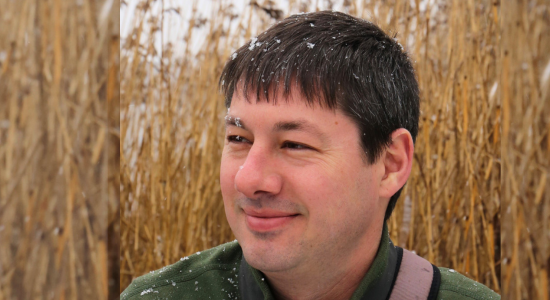Peter A. Hosner
Associate Professor and Curator of birds
Speciation

What is speciation?
Speciation is the process in which populations diverge and become distinct independent evolutionary lineages. Factors including geographical isolation and natural selection promote speciation, whereas the homogenizing effects of gene flow can counter it.
Our research questions
Since the advent of life on Earth, species have proliferated unevenly across the globe, resulting in stark geographic patterns such as diversity gradients, areas of endemism, and regional faunas and floras. We aim to uncover why some diverse evolutionary lineages contribute disproportionately to global patterns, whereas others are composed of relatively few surviving species.
Our research methods
We advance speciation research by generating comprehensive global phylogenies and producing, synthesizing, and curating global-scale spatial and trait datasets. We then use these datasets to test hypotheses regarding geographical speciation patterns and processes via comparisons to null expectations from mechanistic models. A representative selection of research projects within the speciation theme are described below.
Birds are a model group in ecology and evolution because of their well-documented life histories and distributions. Birds provide a great test system for diverse questions about biodiversity. Our research projects include:
The Bird Genome 10,000 Project (B10K)
We work with a large international consortium to develop a comprehensive phylogeny for all bird species based on full genome sequencing. The project will make the annotated genomes available as an open resource for research in phylogenetics, genomics, and evolution of traits.
Contact
Professor Carsten Rahbek
Professor Emeritus Jon Fjeldså
Associate Professor Rute Fonseca
Associate Professor Peter Hosner
The largest avian radiation
The recently published book The Largest Avian Radiation provides a synthesis of the global phylogeny and biogeographic expansion of the largest avian group, the 6000 species of the order Passeriformes. It presents comprehensive results of molecular phylogenetic work and develops questions of greater generality concerning the relative roles of historical contingency, Earth history, and contemporary environmental conditions in producing this radiation.
Contact
Professor Emeritus Jon Fjeldså
Evolution of flightlessness in birds
Birds are nearly synonymous with flight. Yet, secondary loss of flight is pervasive and occurs to some extent throughout the avian tree of life. The research at CMEC uses evolutionary genomic methods to examine the degree to which the evolution of flightlessness is convergent across birds and uncover why some flightless lineages are ephemeral whereas others persist long-term through evolutionary time.
Contact
Associate Professor Peter Hosner
Professor Carsten Rahbek
Evolution of hummingbirds
Hummingbirds captivate researchers and enthusiasts alike with their exceptional flight skills, vibrant plumage, and pollination ecology, making them a fascinating and captivating group of birds. CMEC research delves into the evolution of hummingbirds, placing emphasis on the remarkable diversity and adaptive significance of their bill shapes.
Through comprehensive investigations into the evolutionary patterns and ecological implications of bill shape variations, this program aims to unravel the complex interplay between natural selection, ecological niches, and morphological adaptations in shaping the bill evolution of hummingbirds.
Contact
Professor Carsten Rahbek
Professor Rob Colwell
Professor Gary Graves
Professor Emeritus Jon Fjeldså
Associate Professor Rute da Fonseca
Evolution of Corvides
Corvoid birds, such as crows, ravens, and jays, feature remarkable intelligence, complex social behaviors, problem-solving abilities, and their unique vocalizations, demonstrating a high level of cognitive sophistication among avian species. The research at CMEC on corvoid birds focuses on resolving their evolutionary history, and investigating how they diversified out of Australia before conquering the world.
Contact
Professor Carsten Rahbek
Professor Gary Graves
Professor Emeritus Jon Fjeldså
Associate Professor Rute da Fonseca
We explore the great diversity of phytoplankton and how species evolve in the Oceans.
Contact
Professor Katherine Richardson
Mountains are test systems for exploring questions about speciation and species accumulation. They are complex, and vary from species-poor harsh environments to some of the most diverse places on Earth, with local concentrations of plant and animal species and often with localized distributions. Research projects include:
Speciation in montane regions
We use large phylogenies and distributional databases to study how diversification processes vary across the montane regions of the world and aim to answer general questions about the roles of mountains as "sinks" or "sources" of species diversity.
Contact
Professor Carsten Rahbek
Professor Emeritus Jon Fjeldså
Associate Professor Rute da Fonseca
Associate Professor Peter Hosner
Assistant Professor Hannah Owens
Stability and change in mountains
In this project, we explore the relative roles of stability and change of "cradles" and "sinks" of species diversity, the role of the world’s montane regions and other environments of high species diversity, and how the latitudinal gradient of biodiversity was generated.
Contact
Professor Carsten Rahbek
Professor David Nogués-Bravo
Associate Professor Michael Krabbe Borregaard
Dynamics of island diversity
slands are simplified laboratories for understanding the processes driving global diversity, but they are also unique systems in themselves, with distinct geological life cycles. We investigate what promotes and limits species diversity of islands of different sizes, climates, topographies and, other geological complexities.
Contact
Associate Professor Michael Krabbe Borregaard
Professor Gary Graves
Associate Professor Peter Hosner
To date, research on species’ distributions and drivers of global biodiversity has been dominated by work in terrestrial systems, and uncertainty persists regarding whether terrestrial and marine biodiversity are shaped by analogous processes. We are establishing new analytical procedures for estimating baseline marine diversity patterns and inferring the broad-scale processes that generated those patterns.
Contact
Assistant Professor Hannah Owens
Highlighted papers
Rahbek, C., Borregaard, M. K., Antonelli, A., Colwell, R. K., Holt, B. G., Nogues-Bravo, D., ... & Fjeldså, J. 2019. "Building mountain biodiversity: Geological and evolutionary processes". Science 365(6458), 1114-1119. Download.
Feng, S., Stiller, J., Deng, Y., Armstrong, J., Fang, Q. I., Reeve, A. H., ... & Zhang, G. 2020. "Dense sampling of bird diversity increases power of comparative genomics". Nature 587(7833), 252-257. Download.
Kennedy, J. D., Marki, P. Z., Fjeldså, J., & Rahbek, C. 2021. "Peripheral eco‐morphology predicts restricted lineage diversification and endemism among corvoid passerine birds". Global Ecology and Biogeography 30(1), 79-98. Download.

